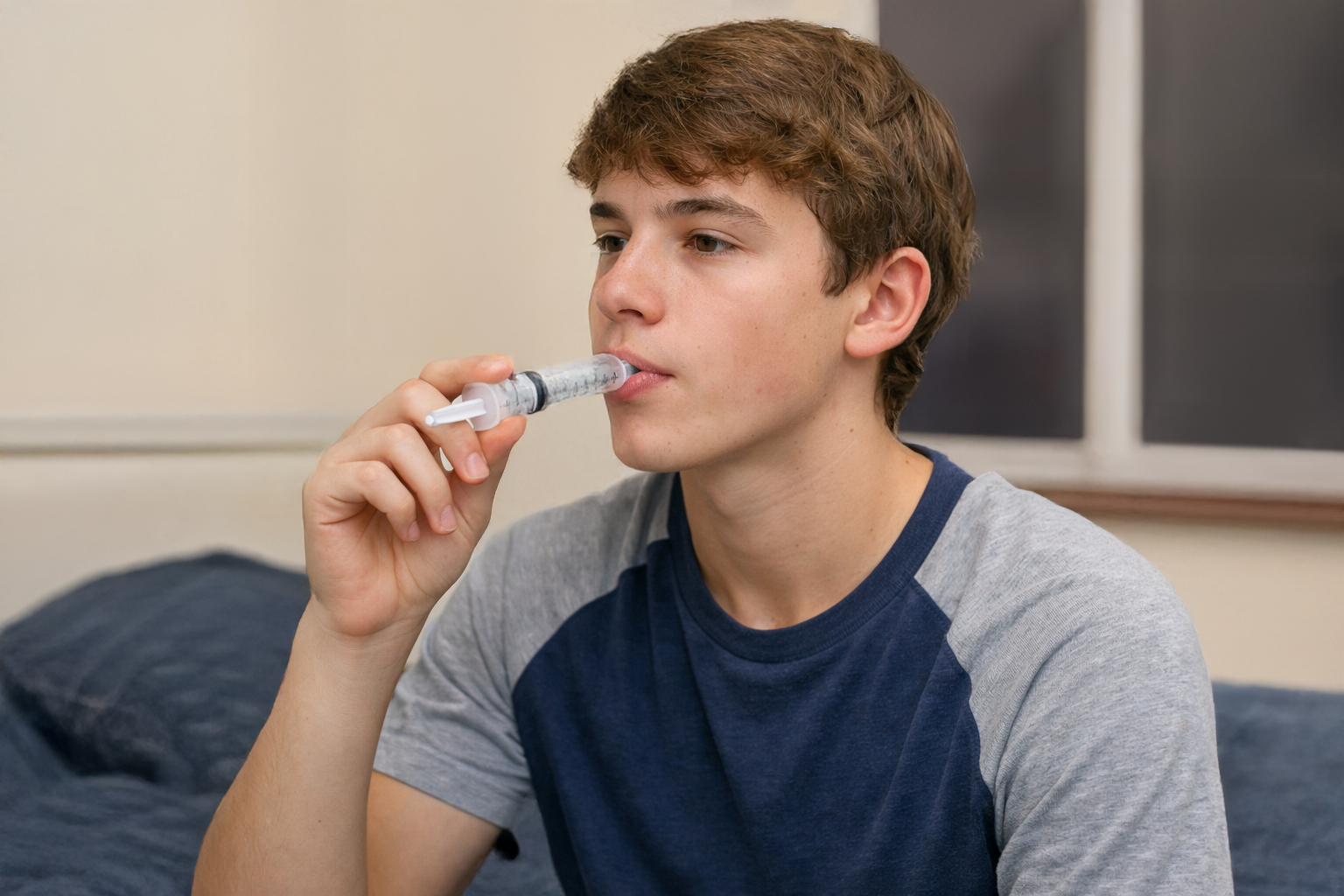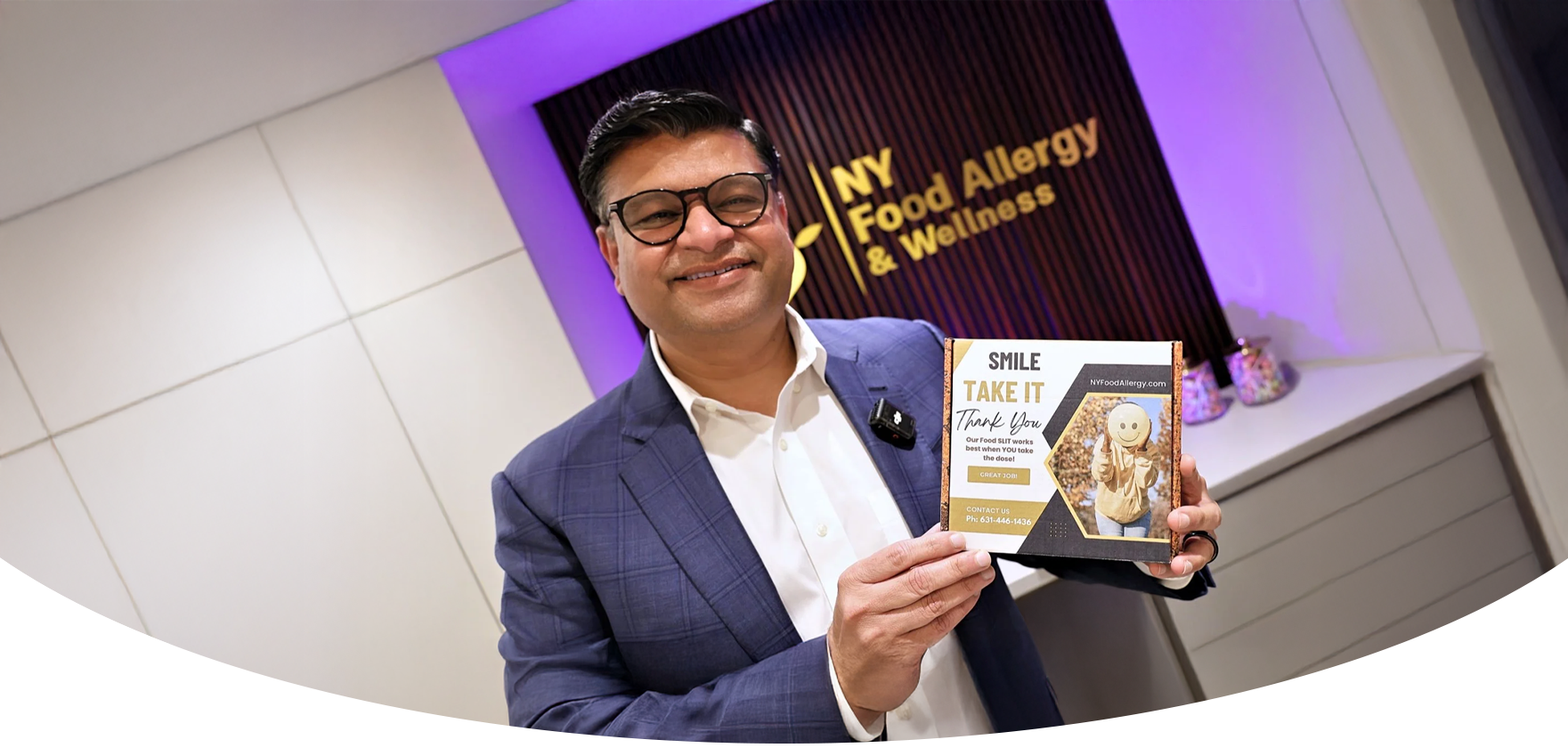Understanding
Sublingual Immunotherapy
Sublingual Immunotherapy, also known as hypo-sensitization, desensitization, or allergy vaccination, is a long-term treatment approach that can reduce hypersensitivity to allergens and related symptoms for many people with allergic conditions, including food allergy. Food immunotherapy is available as food SLIT (sublingual immunotherapy) for some patients with IgE-mediated food allergies.
Food SLIT (Sublingual Immunotherapy) for Food Allergies
What Is Food SLIT?
The current standard of care for food allergy is avoidance and carrying emergency medications for accidental reactions. More patients are also seeking treatment options that may help reduce the risk of severe reactions from accidental exposure to food allergens.
Newer treatment approaches that are available but not widely accepted include food SLIT (sublingual immunotherapy) and food OIT (oral immunotherapy) for various foods.
How Food SLIT Is Taken
Food SLIT involves administering patient-specific food allergen preparations under the tongue, holding the dose in the mouth, and then swallowing, once per day.
Each patient follows an individualized schedule that begins at a safe, low concentration and increases gradually to reach a target maintenance dose.
Office Starts and At-Home Maintenance
Doses are started in the office and increased over a shorter time period until a maintenance dose is reached.
After the first dose of each bottle is administered in the office, daily therapy is continued at home.
What Is Food SLIT?
The current standard of care for food allergy is avoidance and carrying emergency medications for accidental reactions. More patients are also seeking treatment options that may help reduce the risk of severe reactions from accidental exposure to food allergens.
Newer treatment approaches that are available but not widely accepted include food SLIT (sublingual immunotherapy) and food OIT (oral immunotherapy) for various foods.
How Food SLIT Is Taken
Food SLIT involves administering patient-specific food allergen preparations under the tongue, holding the dose in the mouth, and then swallowing, once per day.
Each patient follows an individualized schedule that begins at a safe, low concentration and increases gradually to reach a target maintenance dose.
Office Starts and At-Home Maintenance
Doses are started in the office and increased over a shorter time period until a maintenance dose is reached.
After the first dose of each bottle is administered in the office, daily therapy is continued at home.
Food SLIT Phases and Goals
Build-Up Phase
This phase involves taking SLIT drops once daily with increasing amounts of the relevant food allergens. The length depends on the number of food allergens being administered and the patient’s ability to tolerate the doses.
It may last from about six months to one year.
Maintenance Phase
Maintenance begins once an effective dose is reached. The maintenance dose depends on the patient’s level of allergen sensitivity and response during the build-up phase.
During maintenance, the daily dose is kept the same and continued for an additional 1 to 3 years. We continue or stop food SLIT based on ongoing monitoring and discussion with you.
Many patients may transition to food OIT before or during maintenance. Early studies suggest food SLIT may make the transition to food OIT easier, with fewer side effects for some patients. Some patients may not require food OIT if food sIgE drops significantly during food SLIT.
Goals of Food SLIT
The number one goal is safety. The first objective is to reduce the risk of a severe allergic reaction from accidental exposure or cross-contamination.
The long-term objective is to help the immune system become less reactive to foods containing the allergen by desensitizing immune cells over time.
Build-Up Phase
This phase involves taking SLIT drops once daily with increasing amounts of the relevant food allergens. The length depends on the number of food allergens being administered and the patient’s ability to tolerate the doses.
It may last from about six months to one year.
Maintenance Phase
Maintenance begins once an effective dose is reached. The maintenance dose depends on the patient’s level of allergen sensitivity and response during the build-up phase.
During maintenance, the daily dose is kept the same and continued for an additional 1 to 3 years. We continue or stop food SLIT based on ongoing monitoring and discussion with you.
Many patients may transition to food OIT before or during maintenance. Early studies suggest food SLIT may make the transition to food OIT easier, with fewer side effects for some patients. Some patients may not require food OIT if food sIgE drops significantly during food SLIT.
Goals of Food SLIT
The number one goal is safety. The first objective is to reduce the risk of a severe allergic reaction from accidental exposure or cross-contamination.
The long-term objective is to help the immune system become less reactive to foods containing the allergen by desensitizing immune cells over time.
Ready to Speak With Our Care Team?
GET IN TOUCH
Fill out the form below to begin your journey towards Food Allergy Freedom. Our care team will respond shortly!
Food SLIT Home Dosing and Scheduling
How often will the dose be increased?
Every 7 days at home, Once a month in the office.
How often will the dose be increased?
Every 7 days at home, Once a month in the office.
What time of day should home doses be given?
The dose can be given anytime up to the early evening and should be given about 24 hours apart. Avoid giving after 7 pm. The dose will need to be kept under the tongue for 2 minutes hold and then swallowed. No eating or drinking for 10 minutes afterward is preferred.
How long should my child stay awake after the evening dose?
Children should be observed for at least one hour after the dose is given. They should not be allowed to sleep during this time. Please avoid giving the dose after 7 pm.
How do we dose at home on the day of the monthly office appointment?
Please DO NOT give any dose at home on the day of the office appointment.
What if we are flying when the dose is due?
Do not administer the dose less than one hour before boarding and do not administer the dose while flying. A letter explaining the procedure and need for food SLIT solutions for the Transportation Safety Authority is available upon request. If not sure, skip the dose on the day of travel.
How often will the dose be increased?
Every 7 days at home, Once a month in the office.
How often will the dose be increased?
Every 7 days at home, Once a month in the office.
What time of day should home doses be given?
The dose can be given anytime up to the early evening and should be given about 24 hours apart. Avoid giving after 7 pm. The dose will need to be kept under the tongue for 2 minutes hold and then swallowed. No eating or drinking for 10 minutes afterward is preferred.
How long should my child stay awake after the evening dose?
Children should be observed for at least one hour after the dose is given. They should not be allowed to sleep during this time. Please avoid giving the dose after 7 pm.
How do we dose at home on the day of the monthly office appointment?
Please DO NOT give any dose at home on the day of the office appointment.
What if we are flying when the dose is due?
Do not administer the dose less than one hour before boarding and do not administer the dose while flying. A letter explaining the procedure and need for food SLIT solutions for the Transportation Safety Authority is available upon request. If not sure, skip the dose on the day of travel.
Frequently Asked Questions
Treat the reaction the same way you would any food reaction. The most common reaction is a mild itchy mouth or tongue, which is usually self limiting and goes away without any treatment in a few minutes.
Take an antihistamine if there is mild rash or hives. Use Epi pen or AUVI Q if there are any symptoms of anaphylaxis. If the allergic reaction progresses, call 911 after the appropriate immediate intervention.
Call our emergency phone after you have given appropriate initial treatment. We will give instructions on future dosing.
Most patients on food SLIT will be ready for OIT in 6 months. If needed, food OIT can be started earlier, if we stop the SLIT sooner.
The food SLIT and food OIT of the same food are not necessary at the same time. The food SLIT and food OIT for different foods can be continued simultaneously. We will provide detailed information when you need it.
Yes. It is better to be refrigerated. Avoid putting it in the freezer. It is stable at room temperature for 24 to 48 hours if left out of the refrigerator for any reason.
Please stay on the same bottles and the current dose until you are seen in the office. Please let us know at least two weeks before you travel and we will provide specific guidance.
If it is missed for 3 days, pick up on the standard dosing schedule.
If it is missed between 4 and 7 days, please lower the dose to half for one day and resume the full dose the next day.
If more than 7 days are missed, please call the office before giving the next dose.
When the desired food SLIT maintenance dose has been reached, you will continue that dose daily. Many patients at that stage transition to food OIT.
Those who choose not to start food OIT will continue food SLIT maintenance daily and will come every 2 months for the first dose of new bottles in the office. Lab tests for food specific IgE levels will be done regularly while on maintenance dosing.
No. Exercise restrictions are not needed for food SLIT. There is no rest period required.
1. Yes. You can schedule oral food challenges for other foods during food SLIT. Please do not give food SLIT dose on the morning of the scheduled oral food challenge.
2. Other forms of immunotherapy can be continued during food SLIT. For example, OIT for other foods, OIT maintenance for other foods, and SCIT or SLIT for environmental allergens.
3. Biologics can be continued during the food SLIT as scheduled.
Yes. Each food SLIT protocol is food specific. More than one food SLIT can be started and administered for food allergy symptoms simultaneously. Ask us for more specific information for treating multiple food allergies.
No. Your child must be up to date on all scheduled immunizations before starting any of the food SLIT or OIT programs.
SLIT, or Sublingual Immunotherapy, must be administered by an experienced food allergy expert team, like NYFA.
Severe Multi-Food Allergy Success Story
About Dr. Atul Shah: Testimonials
Possible Risks of Food SLIT
What are the possible Risks of SLIT?
The majority of patients do not experience any symptoms. In a small number of patients, a mild itchy mouth or tongue may occur. It is usually self-limiting and goes away without any treatment in a few minutes.
Less Common Symptoms
Though severe reaction is very uncommon, in some instances, symptoms can include increased allergy symptoms such as sneezing, nasal congestion mild swelling, or hives. Severe reactions to food SLIT are rare but include the possibility of anaphylaxis.
Anaphylaxis and Safety Steps
The signs and symptoms of anaphylaxis include trouble breathing, wheezing or tightness in the chest, hives or swelling, tightness of the throat, hoarse voice, nausea, vomiting, abdominal pain, diarrhea, dizziness, fainting, low blood pressure, rapid heart beat, a feeling of doom, cardiac arrest.
It is necessary to have adult supervision for 30 minutes after administering the food SLIT dose. We advise you to have access to emergency medications, including an epinephrine auto-injector and antihistamines.
What are the possible Risks of SLIT?
The majority of patients do not experience any symptoms. In a small number of patients, a mild itchy mouth or tongue may occur. It is usually self-limiting and goes away without any treatment in a few minutes.
Less Common Symptoms
Though severe reaction is very uncommon, in some instances, symptoms can include increased allergy symptoms such as sneezing, nasal congestion mild swelling, or hives. Severe reactions to food SLIT are rare but include the possibility of anaphylaxis.
Anaphylaxis and Safety Steps
The signs and symptoms of anaphylaxis include trouble breathing, wheezing or tightness in the chest, hives or swelling, tightness of the throat, hoarse voice, nausea, vomiting, abdominal pain, diarrhea, dizziness, fainting, low blood pressure, rapid heart beat, a feeling of doom, cardiac arrest.
It is necessary to have adult supervision for 30 minutes after administering the food SLIT dose. We advise you to have access to emergency medications, including an epinephrine auto-injector and antihistamines.
Get Started Today!
Visit NYFA’s Manhattan Office
NY Food Allergy & Wellness is located on the Upper East Side at 110 East 60th St., Suite 708, New York, NY 10022. Serving all of Manhattan, the NYC metro area, New Jersey, Connecticut, and patients nationwide, as well as international visitors.














